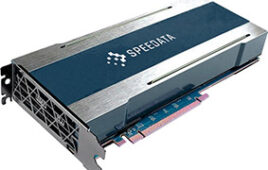 HPC can be a game changer.
HPC can be a game changer.
Thinkplay.tv is a UK company focusing on animations, whose work to date has been featured on S4C, Channel 4, Five, Discovery, myTV (India), Telefonica5 (Spain), PlayStation, Wii and Xbox. Their work requires significant computing power, both in producing the scenes (factoring in lighting, shading, textures and so on) and in rendering them. Previously, on a typical project, each scene took days to render, which limited the number of scenes they could commit to before a typical project deadline. Furthermore, their creativity was limited by their rendering capabilities. Talent rich, resource poor — they could design and build a car, but couldn’t afford to put petrol in the tank.
To find a better solution for their compute needs, Thinkplay.tv turned to high-performance computing (HPC), in this case using HPC Wales systems. With HPC resources, they have managed to reduce their rendering time from four days to four hours and are now able to compete with the biggest and best in their market. Now, they can create film-quality effects in full HD with no problem. They have gained the capacity to increase the size of a job on short notice, for example, when a client asks for more frames. HPC enabled Thinkplay.tv to be more productive as a company, as they no longer need to wait for the rendering to finish. Using HPC technology has helped improve their credibility within their target market — they can do more: bigger, better and faster.
Moleculomics is a Swansea-based SME. The company aims to significantly reduce the time it takes for pharmaceutical companies to bring their new drugs to market. Currently, a typical candidate drug compound takes around 12 years to move from concept to market. Shortening this process could potentially save many lives that would have been lost while waiting for a new cure to become available. Moleculomics’s core business is focused on developing new computational tools (known as pipelines) that take genetic information (in the form of DNA sequences) and automatically convert this into detailed three-dimensional models of all of the proteins within our bodies. Detailed knowledge of every possible structure of a protein would be very valuable to pharmaceutical and biotechnology companies; for example, they could use the pipeline to carry out simulations of the interactions of a new drug with all of the relevant proteins with a much higher specificity. This would mean that drugs could be more accurate in targeting the correct protein, while also ensuring that they are less likely to result in unforeseen side effects due to interactions with other proteins.
In the past, it took three weeks to model a protein. Using HPC resources, the company managed to reduce that time to 12 seconds. And, in fact, from an end user’s perspective, it takes only three seconds from asking a question about a specific protein structure to receiving the answer from the databases — which is life-changing!
HPC enabled Moleculomics to take the lead over their competition through their ability to compute structures for all variants of proteins that are present in the population. They are now beginning to run screening experiments using algorithms to investigate the interaction of these variant structures with candidate compounds for drugs.
Thinkplay.tv and Moleculomics are just two examples among many. In today’s world, high-performance computing has become the competitive edge that can help companies, big or small, to increase their productivity, reduce their time to market, save on development costs, and employ the foremost tools to compete.
Any small engineering and design company should consider using HPC as part of their computer-aided simulation activities. Today, most HPC systems are built from commodity elements of servers, interconnect and storage, or, in other words, a compute and storage cluster. These are not the complex proprietary systems of the past. One can easily build an HPC system by him or herself, and guidelines on how to do so can be found, for example, on the HPC Advisory Council Web site: www.hpcadvisorycouncil.com.
For instance, by buying dual CPU-socket servers from the server company of choice, adding the required amount of storage to maintain files, and connecting it all with InfiniBand interconnect, one can gain the power of supercomputers. There are many HPC sites that provide access to their systems, and the HPC Advisory Council also provides access to various HPC systems in order to test and experience the power of HPC first-hand. There are many applications that the council has pre-tested and provided guidelines on how to best use to form an efficient HPC system.
Using standard-based HPC systems is important for any business to maintain, whether they are new to HPC or experienced. Standard-based solutions ensure backward and future compatibility, ensure support from a large eco-system of vendors and users and, of course, ensure the ability to use many of the open source or open-source based software libraries and applications.
Building a balanced system is another key for a successful HPC infrastructure. Using powerful CPUs (x86, Power or ARM based) with slow network interconnect will degrade the system performance. Nowadays, most of the HPC systems, small or large scale, utilize InfiniBand for system connectivity. The InfiniBand interconnect can be used at various data speeds — from 10Gb/s to 20, 40, 56 and 100Gb/s, and at each speed it enables extremely low latency for data communications and supports multiple accelerations that reduce the CPU overheads and enable more CPU cycles to be dedicated to the application. The many case studies performed by the HPC Advisory Council (available on the council Web site) demonstrate that InfiniBand enables higher application performance versus other interconnect options, starting from four server clusters and up. Therefore, one can execute a network’s application jobs much faster, execute more application jobs at any given time, and save CAPEX and OPEX on the compute infrastructure without sacrificing performance.
High-performance computing can help a business to become more efficient and more productive. And, for a small business, HPC can be a game changer, helping it leapfrog ahead of the competition by reducing its costs and dramatically improving its time to market.
As a member and supporter of the HPC Advisory Council, I encourage all to join the council (free of charge) and to gain better sight into HPC technology and its usage.
Note: The information on the two case studies is courtesy of HPC Wales.
Gilad Shainer is Chairman of the HPC Advisory Council. He may be reached at [email protected].




